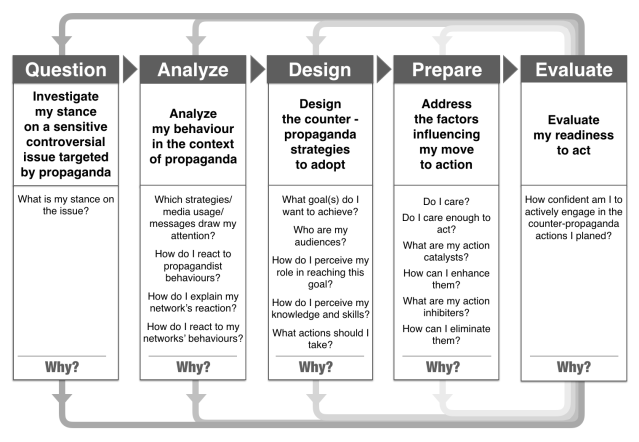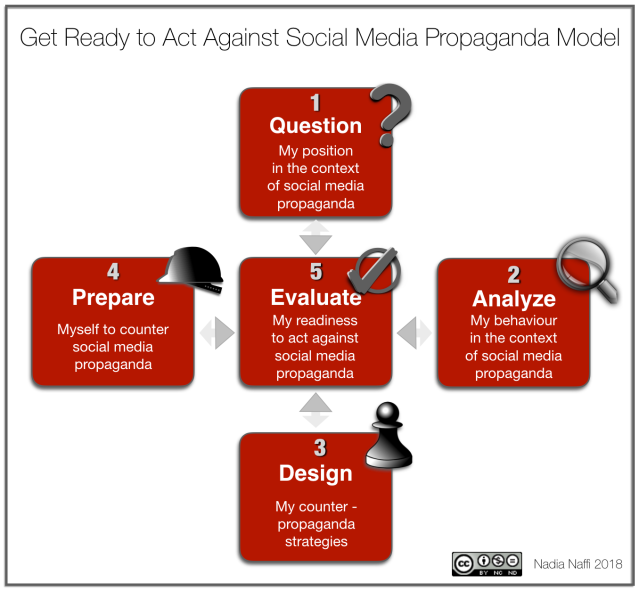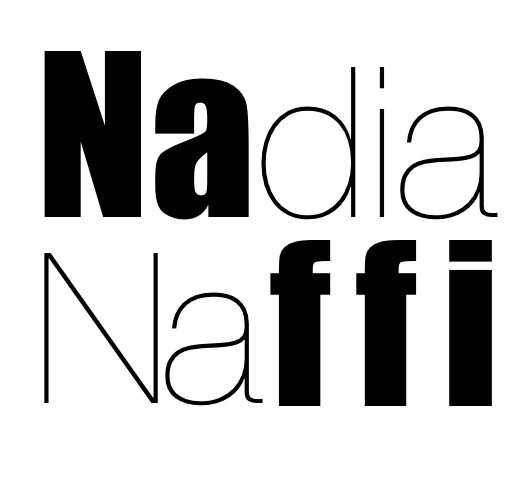Based on the results of my doctoral study, moving from the bystander stance to the active agent of change stance in the context of digital age propaganda targeting a sensitive and controversial issue cannot be done in a snap of a finger. Changing the posture of the passive bystander to the active agent of change is achieved through five iterative stages, in which learning about oneself is key. The five stages are: Question, analyze, design, prepare and evaluate.
The 5 Stages of the Get Ready to Act Against Social Media Propaganda Model
- In the question stage, youth investigate how they construe their stance on a sensitive controversial issue targeted by social media propaganda. Recognizing their position and the genesis of their beliefs sets the stage for examining the behaviours that should, in the proactive scenario, generate from this stance.
- In the analyze stage, youth identify the bystander behaviours they currently exhibit when they encounter or are targeted by social media propaganda about this issue. They discuss how they construe these behaviours and explain the reasons behind them. They also examine their network’s behaviours and how they react to them.
- Once their stance is identified and their current behaviours examined, youth engage in the design stage. In this stage, youth create their own online digital counter-propaganda strategies based on their social media skills and the propagandists behaviours they recognized in the analysis stage.
- After these strategies are detailed, youth consider the catalysts and the inhibitors of their move to action. Designing strategies does not imply their implementation. Thus, In the prepare stage, youth recall the factors that motivate them to engage in the counter-propaganda actions, and address the factors that could hinder their agency.
- The evaluation stage is mandatory before actually moving to action. In this stage, youth evaluate their readiness to act. At that point, youth determined their positioning in regards to the sensitive and controversial issue, they have recognized the reasons why they act as bystanders, and they have designed a clear plan for action and they have addressed the factors that could hold them back. The question that remains is: Are they confident enough to act? Or is a return to a previous stage needed?
Learning about oneself is key in each stage of the model. In the context of this study, the questioning was facilitated through a series of techniques adapted from the Personal Construct Psychology methodology.
These techniques are 1) Kelly’s self-characterization technique, 2) Procter’s perceiver element grid, 3) Kelly’s repertory grid test, and 4) Hinkle’s laddering technique.
These techniques are detailed here.
These four techniques helped generate enough data to determine the stages of a model to move from bystander to agent of change and to extract the key questioning that allows youth to come back to the source of their thinking about the social media propaganda.
However, I acknowledge that it might be very demanding for practitioners to use because the techniques require advanced research methodology training. The model presented proposes a set of questions that was uncovered through using the four techniques with the 42 participants of the study. Through the synthesis of the results, key questions for each stages were coined. All the questions are followed by the “why?” question.

Through the Get Ready to Act Against Social Media Propaganda model I propose based on the results of my study, I posit that learning about oneself and understanding one’s own behaviours in regards to a sensitive and controversial issue targeted by digital age propaganda is key to transform bystanders into agents of change. It helps individuals examine and address what holds them back and equip and empower them to get ready to be actively involved in counter-propaganda behaviours.
However, being ready does not imply going through and taking action. Thus, the model I propose is one phase of a more complex iterative model that would include media literacy, propaganda awareness, action implementations and the evaluation of these actions after adoption.
The strength of this model is its potential transferability to a wide variety of sensitive and controversial political or social issues and to different contexts of tension, where individuals opt for a bystander stance while their agency could make a difference.
In the context of this study, 42 passive bystander youth aged between 18 and 24 years old, supportive of the Syrian refugee resettlement, constructed knowledge about themselves. This knowledge facilitated the development of their agency. Towards the end of the interviews, youth affirmed that they were ready to play an active role in confronting social media propaganda against refugees. Further, they realized that social media propaganda influences people’s offline behaviours towards refugees and they became ready to anticipate offline anti-refugee behaviours and address them.
Requirements to use the Get Ready to Act Against Social Media Propaganda Model and the Techniques Attached to It
To involve youth in learning about themselves and developing agency, I used techniques stemming from Personal Construct Psychology. The uniqueness of these techniques is their power to engage interviewees in in-depth transformative discussions.
Anybody who wishes to use them would need to be immersed in Personal Construct Theory (PCP) and obtain a rigorous training to develop interviewing skills in PCP, such as suspending own personal values, listening credulously, being reflexive and verbally skilled and taking account of culture-dictated constructs.
My knowledge and skills in using the techniques evolved with every interview I conducted. Any educator, social worker, or parent who would choose to use the aforementioned PCP techniques to address sensitive and controversial issues should expect that there is a learning journey involved in using such in-depth discussion approaches.
Learning and Behavioural Goals through Adopting the Model
Adopting this model in the context of digital age propaganda targeting social or political sensitive and controversial issues will engage bystander youth (18 to 24 years old) in the process of actively becoming agents of change, through learning about themselves. Notably, adopting this model will allow 18 to 24 years old to:
- Investigate their perception of the genesis of the issue targeted by the propaganda campaign.
- Recognize their stance on the ideology and purpose of the propaganda campaign.
- Reflect on their positioning in the context in which the propaganda occurs.
- Evaluate their attitudes towards and perception of the propagandists.
- Identify the reasons why they and their network are potential target audiences.
- Explain their interpretation of the main message diffused by the propagandists.
- Predict the different potential interpretations of the propaganda’s main message by different groups.
- Classify the online environments they use in common with the propagandists.
- Recognize their interpretation of propagandist behaviours.
- Analyze their perception of the media used by the propagandists.
- Examine their evaluation of the strategies used by the propagandists to maximize effect.
- Explain their prediction of how these behaviours could influence audience reaction.
- Compare and contrast the online behaviours of propaganda supporters and those engaged in a counterpropaganda, if present.
- Explain their online behavior in the context of the propaganda.
- Explain their anticipation of potential effect of social media propaganda on offline behaviours, if any.
- Discuss potential digital counter-propagandist strategies they might use, such as
- Demonstrating compassion.
- Doing their own research.
- Using multiple digital tools and platforms to ensure high-quality investigations.
- Exploiting social networks in the quest for information.
- Analyzing information credibility.
- Shaping online discourses.
- Identifying target audience.
- Framing the information to create stories.
- Expressing their own perspective with respect and civility in a digital format.
- Accepting to consider others’ arguments.
- Detecting arguments based on fear.
- Using persuasive strategies.
- Engaging in conversations with people with diverse standpoints.
- Anticipating backlash and cyberbullying.
- Investing in expending own online audience that could serve as a vehicle to spread counter-propagandists’ perspectives.
- Designing the digital footprint that will generate from their own civic and political activities.
- Having an influence.
- Going public.
- Inviting others to join the counter-propaganda campaign.
- Mobilizing others for the counter-propaganda cause.
- Building support.
- Circulating multimedia using digital tools, platforms, and social networks.
- Anticipating possible or unexpected outcomes.
- Planning adequate responses to targeted audience.
- Opting for informed arguments.
- Recognizing that all voices matter.
- Acknowledging that making someone change their social or political views is difficult.
- Accepting that change is possible.
- Identifying behaviours to adapt during the process, such as: being patient, creative and persistent.
- Discuss catalysts and inhibitors of counter-propagandist strategies.
- Establish strategies to be active
- enhance the catalysts of their own counter-propagandist behaviours.
- eliminate the inhibitors of their own counter-propagandist behaviours.
- Discuss plans to assess and evaluate their own counter-propaganda actions.
- Evaluate their readiness to engage in counter-propaganda actions.
 The Get Ready to Act Against Social Media Propaganda Model by Nadia Naffi is licensed under a Creative Commons Attribution-NonCommercial-NoDerivatives 4.0 International License.
The Get Ready to Act Against Social Media Propaganda Model by Nadia Naffi is licensed under a Creative Commons Attribution-NonCommercial-NoDerivatives 4.0 International License.



Fantastic peace of work. Just stunning
LikeLike